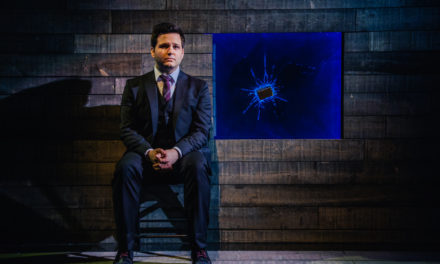It seems simple enough. One is invited to perform somewhere, fills out the necessary paperwork, then performs. For many countries, having international artists work is as simple as that.
“I’ve performed in Prague, the Czech Republic, in Chiang Mai Thailand, I’ve performed across Canada for 15-20 years, and I’d just been invited,” notes Christina Augello, a seasoned fringe performer.
But when it comes to foreign performers working in the US, things get a bit trickier.
Christina Augello was performing at the Canadian fringe when she first encountered Paul David Power’s play Crippled, “I could feel the emotion welling up inside of me… I just was taken by it, it just totally absorbed me. And I thought, God, this is such a beautiful piece of work that needs to be seen.”
Christina was so taken by the piece that she decided to produce the play through her San Francisco based theater company EXIT Theatre. But in order to get Paul (who is Canadian) in the states to perform, the company would have to get him a “P-3 Visa.” A visa made specifically for foreign artists looking to perform in the US.
Getting a P-3 is not only a time-consuming process (the US government shutdown didn’t help matters in this case) but it is also a major financial investment. Paying the legal fees necessary to transverse the US’s immigration system is no small consideration for a theater company. But EXIT Theatre decided Paul’s work was important enough that they would take that on. Unfortunately, Paul and EXIT Theatre were denied the visa by the United States Citizenship and Immigration Services. Why? Because in order to qualify for a P-3 visa an artist’s work must be deemed “culturally unique.” According to USCIS, Paul’s work does not qualify.
Looking at the people EXIT Theatre got to write on Paul’s behalf when applying for this visa (Elizabeth Sweeney from the Canada Council for the Arts, Ryan Kane from Actors Equity, Dr. Kirsty Johnston from The University of British Columbia, among others) it’s clear that Paul’s merits as an artist hardly need bolstering here. However, what does still need to be examined is the implication of the USCIS’s decision and what it has to say about how we view or don’t view disability as a culture.
The USCIS defines culturally unique as “a style of artistic methodology, expression or medium which is unique to a particular country, nation, society, class, ethnicity, religion, tribe or group of persons.”
That last point, “group of persons,” gives this definition some flexibility. Group of persons can mean a lot of different things, but not just any group of persons constitutes a culture. Would a group of people with brown hair constitute a culture? Likely not. This broadness gives the USCIS the power to make judgment calls about what groups of people do or do not constitute a “unique culture.” Cases like Paul’s give us a tangible reference point about what precedents they are setting. In this case, against the idea that disability narratives qualify as “culturally unique.”
So why this push back against the idea that a disabled performer telling a disabled story, is culturally unique? It makes sense when you consider the ways “disability as culture” gets push back in a broader context.
One might first look at the ways our society dissociates disability from personhood. The US is a country that, traditionally, is built on narratives that value individualism. Because of this, we often see disability framed not as a central component of how someone experiences the world, but rather as an obstacle that an individual has to overcome. The problem with this frame is it reinforces the idea that disability has an inherently negative connection, and therefore one should always attempt to separate the individual from the disability.
Consider the kind of language we use when dealing with other cultures, and see how it differs from how we talk about disability. One doesn’t refer to someone as a “person with blackness” or a “person with queerness.” In these cases, we use identity first language, language that validates something as a fundamental part of someone’s personhood. “Black,” “Queer,” “Disabled.” To label these things as something one possesses as opposed to something one is makes them sound like invasive traits, in the same way we might say “person with cancer.” One has cancer. One is disabled. How can we possibly acknowledge something as a culture, while framing the very thing that ties the culture together as undesirable?
This problem doesn’t just exist in the language we use, it exists in the stories we tell. Too often, disability narratives are framed as a battle between an individual and their own body. These narratives are designed to invoke a sense of pity or even fear. In the Exit Theatre’s application Dr. Kristy Johnson invokes theater’s long history of this, pointing to “Sophocles’ blind Oedipus, Shakespeare’s deformed unfinished Richard III, and Tennessee William’s limping Laura Wingfield.”
It’s also worth noting that in all three of those prominent disabled roles, disability serves to extend a thematic metaphor, not to convey the reality of a lived existence. Even when narratives aren’t using disability to invoke a symbolic pity or fear, they too often use disability to lazily imbue a character with “underdog-ness,” in a similar manner we see in inspiration porn. Meanwhile plays like Crippled, where Paul pushes disability narrative beyond our antiquated uses of it, are sidelined.
It’s unsurprising to see a disability narrative dismissed as “not culturally unique” since disabled folk’s cultural narratives, the narratives of their lived experience, are so often supplanted by ones of “pity and fear” or “individual tenacity.” The irony is, these factors that cause “disability as a culture” to get dismissed and prevent Paul from performing here, are the very same reasons why we need artists like Paul in the first place. We need disability narratives that are told by disabled folk because they can uniquely speak to their own culture. Thus, avoiding the harmful and stigmatizing uses of disability we traditionally see in the theater.
The sad truth is, in a country where abled actors playing disabled roles is still rampant, the mere act of seeing a disabled body on stage telling disabled stories, is in fact, unique. To call Paul’s work otherwise demonstrates that the USCIS does not have the proper qualifications or knowledge needed to make judgment calls about the American theater’s needs. Unfortunately, this production won’t likely be coming to the US. EXIT Theatre is appealing the visa case, but the people who judge that appeal are the same people who denied the visa in the first place, the USCIS.
This post was written by the author in their personal capacity.The opinions expressed in this article are the author’s own and do not reflect the view of The Theatre Times, their staff or collaborators.
This post was written by Cortland Nesley.
The views expressed here belong to the author and do not necessarily reflect our views and opinions.


















